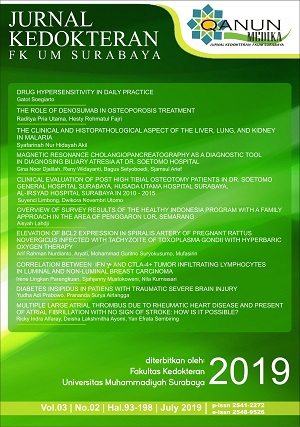The Role Of Denosumab
Abstract
ABSTRACTÂ
Osteoporosis is one of the most common chronic diseases. This condition makes bones in a person to become more porous and fragile, therefore greatly increase their risk of suffering a fracture. In Asia, the mortality rate that are associated with these fractures occurred between 10–20% of cases within a year. Osteoporosis is a condition in which there is an imbalanced activity between osteoblast and osteoclast. Osteoblast and osteoclast are two types of bone cells that majorly involve in bone remodelling process. Osteoclasts adhere to the bone surface once it mature, after that osteoclast both produce and secrete chloride acid (HCl), which will acidify bones and dissolve the bone mineral. Receptor Activator of Nuclear Factor kappa B Ligand (RANKL) is one of the necessary factors in bone remodelling process. It will activate and mature the osteoclast. Denosumab is a monoclonal antibody that will inhibit the binding of RANKL to its receptor, decreasing osteoclastogenesis and bone-resorbing activity. This inhibiting activity will theoretically increase the bone mass density in ones’ body, ergo will treat and prevent osteoporosis. Denosumab showed favourable effect on bone metabolism without having serious adverse events compared to control group. This paper reviews the clinical pharmacology, pharmacokinetic and pharmacodynamic properties, and tolerability in the denosumab in the management of osteoporosis.
Keywords                  : Denosumab, RANKL, osteoporosis, treatment
Correspondence to     : radityapu@gmail.com
ABSTRAKÂ
Osteoporosis adalah salah satu jenis dari penyakit kronis yang sering terjadi. Penyakit ini menyebabkan tulang seseorang menjadi lebih berongga dan rapuh, kondisi ini meningkatkan risiko patah tulang pada orang-orang tersebut. Di Asia, mortality rate yang berhubungan dengan kejadian patah tulang ini berkisar antara 10 – 20% dalam satu tahun. Osteoporosis adalah suatu kondisi dimana terjadi ketidakseimbangan antara osteoblast dan osteoklas. Osteoblas dan osteoklas adalah dua tipe dari sel tulang yang berperan pada proses bone remodelling. Setelah matang, osteoklas akan menempel pada tulang untuk menghasilkan dan menyekresi HCl, yang dimana zat ini akan mengasamkan tulang dan meluruhkan mineral di tulang.  Receptor Activator of Nuclear Factor kappa B Ligand (RANKL) adalah salah satu faktor yang dibutuhkan dalam proses remodelling tulang. RANKL akan mematangkan dan mengaktifkan osteoklas. Denosumab adalah antibody monoclonal yang menghambat ikatan dari RANKL kepada reseptor dari RANKL, menurunkan proses osteoklasogenesis dan aktivitas penyerapan tulang. Secara teori proses ini akan meningkatkan massa dari tulang dan mencegah osteoporosis. Denosumab menunjukan efek yang sbaik pada metabolisme tulang tanpa menunjukkan efek samping yang serius. Makalah ini akan meninjau tentang farmakologi klinis, farmakodinamik , dan farmakokinetik, serta tolerabilitas dari denosumab dalam terapi osteoporosis.
Kata kunci                : Denosumab, RANKL, osteoporosis, treatment
Korespondensi            : radityapu@gmail.com
Full text article
References
AMGEN Inc. (2010) ‘ProliaTM (Denosumab)Injection,for Subcutaneous use : US Prescribing Information’.Available from https://www.pi.amgen.com/~/media/amgen/repositorysites/pi-amgen.com/prolia/prolia_pi.pdf
Bekker, P. J. et al. (2004) ‘A single-dose placebo-controlled study of AMG 162, a fully human
monoclonal antibody to RANKL, in postmenopausal women’, Journal of Bone and
Mineral Research, 19(7), pp. 1059–1066. doi: 10.1359/JBMR.040305.
Bone, H. G. et al. (2017) ‘10 years of denosumab treatment in postmenopausal women with
osteoporosis: results from the phase 3 randomised FREEDOM trial and open-label
extension’, The Lancet Diabetes and Endocrinology, 5(7), pp. 513–523. doi:
1016/S2213 8587(17)30138-9.
Bridgeman, M. B. and Pathak, R. (2011) ‘Denosumab for the reduction of bone loss in
Postmenopausal osteoporosis: A review’, Clinical Therapeutics. Elsevier Inc., 33(11),
pp. 1547–1559. doi: 10.1016/j.clinthera.2011.10.008.
Brown, J.P. et al. (2009) ‘Comparison of the Effect of Denosumab and Alendronate on BMD and
Biochemical Markers of Bone Turnover in Postmenopausal’, 24(1). doi:
1359/JBMR.0809010.
Burkiewicz, J. S., Scarpace, S. L. and Bruce, S. P. (2009) ‘Denosumab in osteoporosis and
oncology’,Annals of Pharmacotherapy, 43(9), pp. 1445–1455. doi:
1345/aph.1M102.
Compston, J. et al. (2017) ‘UK clinical guideline for the prevention and treatment of
osteoporosis’, Archives of Osteoporosis. Archives of Osteoporosis, 12(1). doi:
1007/s11657-017-0324-5.
Cumming, S.R. et al. (2009) ‘Denosumab for prevention of fractures in postmenopausal women
with osteoporosis’, Obstetrical and Gynecological Survey, 64(12), pp. 805–807.
Kenkre, J. S. and Bassett J. H. D. (2017). The Bone Remodelling Cycle. doi: 10.1177/0004563218759371.
Langdahl, B. L. et al. (2015) ‘A 24-month study evaluating the efficacy and safety of
denosumab for the treatment of men with low bone mineral density: Results from the
ADAMO trial’, Journal of Clinical Endocrinology and Metabolism, 100(4), pp. 1335
doi: 10.1210/jc.2014-4079.
Lewiecki, E. M. and Bilezikian, J. P. (2012) ‘Denosumab for the treatment of osteoporosis and
cancer related conditions’, Clinical Pharmacology and Therapeutics, 91(1), pp. 123
doi: 10.1038/clpt.2011.268.
Lewiecki, E. M. (2018) ‘New and emerging concepts in the use of denosumab for the treatment of osteoporosis’, pp. 209–223. doi: 10.1177/1759720X18805759.
Lorentzon, M. et al. (2015) ‘Osteoporosis : The Evolution of Diagnostic’. doi: 10.1111/joim.12369.
Mithal, A. and Kaur, P. (2012) ‘Osteoporosis in Asia : A Call to Action’, pp. 245–247. doi: 10.1007/s11914-012-0114-3.
Miller, P. D. et al. (2008) ‘Effect of denosumab on bone density and turnover in
postmenopausal women with low bone mass after long-term continued, discontinued,
and restarting of therapy: a randomized blinded phase 2 clinical trial.’, Bone, 43(2), pp.
–9. doi: 10.1016/j.bone.2008.04.007.
Moen, M. D. and Keam, S. J. (2011) ‘Denosumab Postmenopausal Osteoporosis’, 28(1), pp. 63–82. doi :10.2165/11203300-000000000-00000
Mohd-Tahir, N. A. and Li, S. C. (2017) ‘Economic burden of osteoporosis-related hip fracture
in Asia: a systematic review’, Osteoporosis International, 28(7), pp. 2035–2044. doi:
1007/s00198017-3985-4.
Ryman, J. T. and Meibohm, B. (2017) ‘Pharmacokinetics of Monoclonal Antibodies’, (June), pp. 576–588. doi: 10.1002/psp4.12224.
Scott, L. J. and Muir, V. J. (2011) ‘Denosumab’, 71(8), pp. 1059–1069.
Tabatabaei-Malazy, O. et al. (2017) ‘New horizons in treatment of osteoporosis’, DARU,
Journal of Pharmaceutical Sciences. DARU Journal of Pharmaceutical Sciences, 25(1),
pp. 1–16. doi: 10.1186/s40199-017-0167-z.nces
Wu. et al. (2009) ‘Denosumab Compared To Bisphosponates to Treat Postmenopausal Osteoporosis : A Meta-analysis’, Journal of Orthopaedic Surgery and Research (2018) 13:194. doi.org/10.1186/s13018-018-0865-3
Authors

Qanun Medika by FK UM Surabaya is liscence under Lisensi Creative Commons Atribusi 4.0 Internasional.

